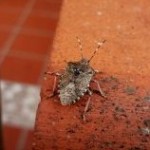 I am certain that most people reading this post have experienced the invasion of the stink bug. Unfortunately, Smith Mountain Lake is not immune to this pesky little insect any more than the rest of the country.
I am certain that most people reading this post have experienced the invasion of the stink bug. Unfortunately, Smith Mountain Lake is not immune to this pesky little insect any more than the rest of the country.
First reported around Allentown, Pa. in 1996, the Asian Marmorated stink bug probably arrived with goods shipped in from China and has since made remarkable progress across the country. From the mid-Atlantic states into the Pacific Northwest, they are rapidly overtaking populations of native stink bugs, which once primarily bothered only cotton farmers in the Southeast.
These insects are called stinkbugs because they possess a gland that releases a foul, musty odor as a means of self-defense when they feel threatened by a bird, lizard, human, etc. Squashing, vacuuming, and so forth will often trigger their defensive scent. Wear gloves if you need to touch stink bugs because their tiny beaks are capable of harmless but irritating bites.
In North America, there are around 80 different species of stink bugs. Some of these species eat ladybugs and caterpillars, while others love to eat cabbage and green beans. The stink bug’s eggs are yellow, yellow-red, white, or pale green and can be found on the underside of leaves in clumps of 20 to 30 eggs. Thank goodness stink bugs cannot reproduce indoors and so their eggs are only located on outdoor plants. Other things stinkbugs eat are nuts, honeydew, tomatoes, beans, corn, squash, peppers, cabbage, and any type of fruit, using their beaks to pierce and suck plant juice. So you can see how this bug is a potential hazard to our gardens.

